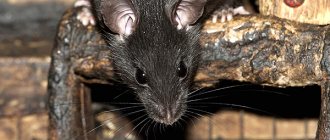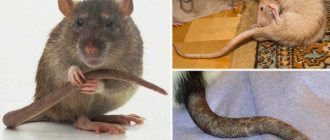A rat is an animal that is included in the genus of rodents in the mouse family. More than 60 species are known. Recently, decorative representatives have become increasingly popular. Such pets have high intelligence. They are very interesting to watch. Decorative rodents do not take up a lot of space and do not require complex care. Often people who want to have such a pet are concerned about how long pet rats live. Unfortunately, the life cycle of rodents is short. It can be extended by following basic recommendations. Life expectancy directly depends on many factors.
Lifespan depending on breed
Compared to other four-legged friends, domestic rats do not live long - on average from 1.5 to 2 years. However, under favorable conditions, the pet can reach an advanced age - about 4 years.
The main factor influencing the life span of a rat is heredity. Therefore, when choosing a pet, you need to consider the breed:
- The Sphynx is one of the most vulnerable species. The animals are hairless and are also endowed with many genetic diseases from birth. Therefore, most of them die at the age of 2 years. Moreover, obvious health problems begin at the age of 1.5 years.
- White - like any albinos in the animal world, representatives of this breed are also not distinguished by good health. They die on average at the age of 2 years, provided that the pet was well cared for.
- Dumbo, satin, rex are artificially created breeds. Breeders took care to minimize hereditary pathologies. Therefore, decorative rats have relatively good health. And with proper care they can easily live up to 3 years.
- Fuzz are small rats with slightly curling whiskers and fur. Representatives of this breed are considered long-lived. On average, a healthy individual lives up to 3.5 years.
The Guinness Book of Records includes a domestic rat that lived to be 7 years old. At the same time, the pet owner claims that the secret of the rodent’s longevity is that the animal lived in love and harmony with all family members.
Why is it worth buying a rodent for your home?
Any, even the most unpretentious pets at first glance require care: proper nutrition, timely medical care, provision of the “correct” living conditions, education and training. The only question is how much time and finances have to be spent on providing appropriate care.
The dog needs frequent walks. And walking with four-legged pets is not only a pleasant pastime in the fresh air, but also constant washing of paws, examinations for ticks, treatment for minor cuts and other injuries.
In addition, dogs require mandatory training. Yes, yes, even small decorative dogs taken into the home solely “for pleasure” should know the boundaries of what is acceptable and have a clear idea of what is allowed and what is not allowed.
Cats, unlike dogs, do not require obligatory walking and, in general, behave more independently. However, at the same time, many pet owners note the waywardness or even “capriciousness” of their pets.
If a dog is a pack animal and therefore requires constant communication, then cats most often behave like loners. Yes, the cat can climb onto your lap or “ask” for attention, but he will only do this when he wants. Cats carefully respect their personal boundaries. The scars on the hands of their owners are further confirmation of this.
Parrots and other feathered pets do not require as much space as cats and dogs. However, they need almost the same amount of attention. Parrots are sociable guys, which means that they definitely need an “interlocutor.” If you don't have time to play with your pet, you will have to get two birds at once - but in this case you may turn out to be a “third wheel” for them.
The fish are too “asocial” and require special care. Aquarium keeping is a serious hobby, often expensive and requiring certain skills. Before acquiring a “real” aquarium, a beginner will have to get his hands on less demanding pets.
- Top 7 aquarium fish for beginners
Do you dream of aquarium fish, but are you afraid of not being able to cope? Let's talk about the easiest types and breeds to care for.
Turtles , both waterfowl and land ones, require special conditions of detention. Correct levels of humidity and air temperature, absence of drafts, a certain ventilation regime - ensuring all this may not be as simple as it seems at first glance.
At the same time, domestic rodents do not require as much communication as dogs, do not behave as capricious as cats, do not make noise like parrots, and do not require special conditions like fish or turtles.
Do not think that the list of domestic rodents is limited to hamsters and guinea pigs. In reality there are many more. Let's talk about the most popular ones.
Why do rats die at home?
The rat is a fairly active animal, constantly exploring the surrounding space, tasting new objects. Therefore, rodents often die prematurely due to the carelessness of the owners who did not protect the pet from potential dangers. The causes of early death of domestic rats are often:
- injuries received from other pets (cats or dogs);
- eating plants dangerous to rats (geranium, aloe, tulip, daffodil, dieffenbachia);
- chewing electrical wires;
- falling out of a window or balcony;
- great fear.
Also, rat owners often inadvertently step on or sit on the animals. Fluffies are very nimble and easy to miss, especially in the evening and at night. Therefore, in order to avoid troubles, it is necessary to organize a safe walk for them in a fenced area. The rest of the time, the pet rat should be kept in a tightly locked cage.
Chinese hamster
Chinese hamsters differ from their relatives from the Hamster family by their more elongated body proportions.
Young individuals are not very flexible, but if the animal is often communicated with, it very quickly gets used to being handled and even becomes attached to its owners. At the same time, Chinese hamsters do not get along well with their relatives. This is especially true for males, who have a habit of constantly entering into conflict due to the fact that they cannot divide the territory.
There are three types of color: gray (the so-called wild type), spotted white, white (a rather rare variety). They are known for their speed and resourcefulness, so such pets should be kept in a cage with a small distance between the bars. Some owners even set up a special aquarium for them.
Common Rat Diseases
Health status has a significant impact on the lifespan of pet rats. Their eyelids are shortened by the following diseases:
- Obesity . Owners often feed cute fluffies with various treats. In an effort to pamper their pet, breeders often do not notice that the animal’s body weight is growing too quickly. As a result, the rat gets problems with the heart and blood vessels.
- Mycoplasmosis is a disease of the respiratory system that develops against the background of infection entering the body. The danger is that symptoms appear only at a late stage. The main signs of the disease: decreased activity, red discharge from the nose and eyes, difficulty breathing, wheezing, coughing, sneezing. In the absence of timely treatment, the disease develops into pneumonia.
- Neoplasms . Rats are characterized by both benign and malignant tumors. The danger of the pathology lies in the fragility of animals and their small size. Veterinarians do not always undertake to perform surgical operations on rats. In some cases, with oncology, pet rats simply live out the time allotted to them without receiving treatment.
- Scabies . It occurs when one of the types of mites settles on the skin: itch, skin beetles or skin mites. When sick, the animal itches a lot, scratching its skin until it bleeds. Also, the animal’s hair falls out in clumps, the pet becomes restless and cannot find a place for itself. If the form is neglected, the fluffy may die.
If a rat has fleas or helminths, scabies can be transmitted to humans. Therefore, a sick animal needs to be shown to a veterinarian as soon as possible and treated.
Also, to avoid infection with scabies, special attention should be paid to personal hygiene - thoroughly wash your hands with soap after each touch of the animal.
Impact on the life expectancy of a home
The lifespan of rodents is greatly influenced by the arrangement of the cage. If the cage is small and does not contain entertainment structures, the pet will be inactive. This will negatively affect your well-being in the future. This may cause:
- the occurrence of excessive body weight;
- muscle atrophy;
- cardiovascular pathologies.
The cage should not be placed in direct sunlight. The animal may overheat. Decorative rats do not tolerate heat well. It can cause a cold. The dwelling is located in the shade, but not placed in a dark place. You cannot use an aquarium instead of a cage. There is not enough air entering the vessel. All food and water containers must be kept clean. It is important to change the filler as often as possible.
How to increase your life expectancy
The lifespan of pet rats depends not only on genetics and diseases. You can extend the life of a fluffy by creating ideal conditions for him.
Nutrition
For normal growth and development, your pet needs a balanced diet. 80% of the animal’s diet should consist of cereals. The most useful are corn, oats, wheat, rice, barley, and buckwheat. The remaining 20% accounts for the share of fruits, dried fruits, vegetables, nuts, and herbs.
There should always be fresh water in the animal's drinking bowl. During the period of intensive growth, the rat needs protein. Therefore, the rodent is allowed to give a little boiled lean meat (chicken breasts, rabbit, turkey) and hard-boiled eggs.
Fried and fatty foods, sweets, cakes, pastries, white bread, fast food, as well as salads, soups and other ready-made dishes are prohibited. Such treats will not only be of no benefit, but will also shorten the rat’s lifespan.
Dental health
The health of the rat’s entire body directly depends on the health of its teeth. Therefore, they must be carefully looked after. To avoid dental problems, it is enough to place a piece of chalk or a strong branch in the cage. The pet will be happy to sharpen its teeth on them.
Conditions of detention
The pet’s well-being, and therefore its health, including psychological, directly depends on the conditions of detention. To make your rat feel comfortable, you will need:
- Buy a spacious cage with metal rods . Inside there must be a drinking bowl, a feeding trough, a shelter house, a sleeping place and sports equipment (wheels, ladders, labyrinths, tunnels). Read the full list of what you can buy for a rat here.
- Create appropriate environmental conditions . The room with the cage should be cool. Ideal temperature is +18-20°C. You also need to make sure that the rat is not exposed to sunlight. Additionally, you should protect your fluffy from loud sounds, strong odors, and the sudden invasion of strangers or animals into the room.
- Buy a companion for your rat . Living alone greatly depresses the nervous system of rodents. It is better to choose a same-sex animal as a cagemate. Since bearing cubs and frequent childbirth negatively affects the health of females and significantly reduces their life expectancy.
- Periodically walk the animal in the fresh air . This will improve his mood and also strengthen his immune system. Only all walks should be under close supervision.
Another important condition is the unconditional love of the owner. Only by completely trusting a person will a pet rat feel safe, which will have a beneficial effect on its psycho-emotional background.
Cleaning and cleanliness in the cage
Cleanliness is the key to health. Therefore, the bedding in the cage needs to be changed as it gets dirty - 1-2 times a week. The animal's dishes must be washed thoroughly every day. Leftover food should be removed 20-30 minutes after the start of the meal to avoid poisoning. And once a month it is necessary to carry out complete disinfection inside the home.
The rodent itself also needs to be bathed periodically. Rats love water very much. The bath can be organized using any shallow container so that the liquid does not cover the pet’s head. For convenience, you can put a small wooden raft in the bath, which the fluffy will happily climb on. It should be taken into account that the water should not be hot, and for hygiene procedures it is better to buy specialized products at a pet store.
How to extend the life of a pet? Recommendations for owners
It is very important to treat all diseases in a timely manner and prevent them from becoming chronic. Not everyone understands the anatomy of rats, and even fewer people know about possible diseases.
In this case, you can contact a veterinary clinic; now almost all specialized clinics have a doctor who treats rodents directly - a ratologist. In small towns, it will most likely be difficult to find such a specialist, but even an ordinary veterinarian can easily diagnose the disease and prescribe therapy.
In addition to health, it is important to pay attention to the maintenance of your pet; for a comfortable life, rats require a spacious cage, which will be equipped with everything necessary.
The litter you choose for your cage is also important. Many people are not aware that woody ones are not desirable for use in rat cages. This is due to the content of essential oils in the tree, which can cause allergic reactions or diseases of the ENT organs.
When buying a new pet, you should isolate it from other pets for a month so that the animal undergoes adaptation and adapts to foreign bacteria. To do this, it is worth placing the cage in a room where other animals will not have access.
Conditions for keeping rats and cage hygiene
Life expectancy is closely related to the hygiene and living conditions of decorative rats, for example:
- the size of the home - the more animals, the larger the area should be. Females require tall cages, while males, on the contrary, prefer a larger area;
- accessories - ladders and shelves are necessary to maintain physical activity;
- couple - it is important not to forget that in the wild these animals live in packs, and it is best to keep several individuals at once (of the same sex - unless you plan to become a breeder);
- walks - by purchasing a walking ball, you will provide the opportunity for even greater activity of the rodent, and besides, it is safe;
- care - rats are social animals, they become attached to members of the household and require attention and care.
If you can provide your rodent with all the necessary conditions for a comfortable life, you will contribute to his long and happy life.
| Necessary | Running wheel; shelves; ladders | walking ball | Cage dimensions | Proper nutrition |
| What does it affect? | Prevention of excess weight; prof muscle atrophy | Safe walks, additional physical activity | Promote a stable emotional background, space for physical activity | Disease Prevention |
Proper nutrition
Life expectancy in the wild directly depends on the nutrition of the rodent, often this is insufficient or poor nutrition:
- Foraging for food in landfills.
- Feeds on small animals and insects.
- The predominance of plant foods.
- Cannibalism - in conditions of hunger, rats often eat their relatives.
Settling in cities or near them, many rats die from the poison that people spread to fight animals.
For a long and healthy life, a rat should eat about 80% grains and about 20% vegetables/fruits/greens. There must be constant access to clean, usable water.
The decorative rat will also need a mineral stone for grinding down its teeth.
Young rats should be fed boiled meat and eggs at least once a week. Sometimes you can pamper them with nuts. Sprouted grains have a tonic effect and prevent many diseases, so they are also recommended to be added to the diet of decorative rats.
How long do wild rats live?
Wild rats have impressive body sizes; their weight can be up to 0.5 kg. Therefore, novice breeders often think about taming them, mistakenly thinking that due to their size they will live longer. In fact, everything is exactly the opposite.
Wild rats are not adapted to life in a domestic environment. They cannot stand confined spaces and are very afraid of people. Therefore, in captivity they live 1-1.5 years. In addition, savages are more susceptible to cancer.
How long a rat can live at home is a controversial question. Much depends on the person - the owner can either extend or shorten the pet’s age. In order for the fluffy to please all family members for as long as possible, it is necessary to organize good living conditions for him, as well as give the animal unlimited care and love.
Genetics
The lifespan of a house mouse is influenced not only by lifestyle, but also by genetic predisposition.
The fact is that in pet stores, rats live in mixed-sex packs , which does not happen in the wild. Animals living in crowds mate uncontrollably, after which they live in cramped conditions unsuitable for normal existence. It is very difficult to trace the genetics of such an animal, so it is impossible to say how long such a rat will live and what life awaits it.
A completely different situation arises when animals are bred by a breeder. Matings in such cases are planned, and partners are selected depending on temperament. Rat pups from peaceful, sociable parents are prepared for sale as pets. Such babies are brought up in a favorable environment, which prevents the pet from displaying aggression in the future.
Females in nurseries give birth to cubs no more than twice a year . Frequent pregnancies exhaust the animal, as a result of which it produces weak, non-viable litters.
In order for a pet to be healthy, please its owners and live a long life, it must be purchased only in special institutions.
You will learn how to make the life of a pet rat comfortable in this video.
What factors does it depend on?
Experienced breeders know how long rats will live at home - this largely depends on the pedigree of the animals. In other words, the lifespan of a house mouse is directly related to genetics.
If parents are sick, they will not have healthy children. Weak children are also born from close relatives. These children live short lives and often get sick. Only healthy animals with the desired coat pattern and color are selected for crossing.
Accordingly, in order for pet rats to please their owners for a long time, it is advisable to purchase them in kindergartens, where specialists monitor the reproduction and treatment of their charges.
In addition to the child’s pedigree, future nursery owners will be told how to care for them, what they can and should be fed, what vaccinations they received and what needs to be done.
A healthy and rich diet for your pet will also ensure a long and happy life. Human food and junk food can cause illness and premature death in an animal.
Do not spoil your pet with chips, sweets and other similar treats.
The living conditions of pets are very important, so it is necessary to provide rats with everything they need.
Caring for an elderly kitty rat
An elderly rat really needs your attention
It is morally difficult for a loving owner to accept the thought of the imminent death of a devoted animal; many owners do not know what to do if a rat dies of old age. It is impossible to calculate the time of death or prolong the life of a domestic rodent; immediately before the death of the animal, heavy breathing or convulsions may be observed, sometimes a beloved animal simply dies in its sleep. Elderly pets are in great need of increased care and attention from their adoring owner, so it is necessary to take care of the aging animal as often and intensively as possible. The owner of an elderly pet must:
- remove all floors from the cage, place the hammock, house, feeder and drinking bowl as low as possible;
- if necessary, independently place a weak rodent in a warm hammock;
- after each feeding, it is necessary to wipe the pet’s nose, mouth and eyes with a damp swab, once a day to wash the intimate parts with a solution of chlorhexedine and the ears with a cotton swab dipped in saline solution;
- due to age-related dental problems, it is recommended to feed an elderly pet with semi-solid and soft food: porridge, dried bread, cereal, baby food, yogurt;
- if the animal cannot drink from a nipple drinker, you can secure a cup of water in the cage and treat the rodent with juicy fruits and berries;
- Vitamins for rats must be included in the diet;
- Slatted floors and coarse litter are not used for elderly pets; it is recommended to lay soft fabrics, napkins, and toilet paper on the bottom of the cage as bedding;
- It is advisable to frequently communicate with the rat, stroke the animal, hold it on your lap; elderly rats need human affection and attention more than ever.
Attitude towards a person
The decorative albino rat is a tame and loving animal. He is trainable, cunning and intelligent. Many owners claim that the rat quickly learns to open the lock on the cage. She thinks quickly, and is significantly different from her dark brothers. Watching your pet play is a pleasure. The Internet is full of videos where albinos willingly perform various tricks, climb around the room, and simply live.
A kind and gentle rat loves its owner. I’m ready to spend whole days on my hands, knees, or in my pocket. Having settled comfortably on a person, she shows her affection with all her appearance. She climbs into her arms to be stroked on her back.
Regular communication with your pet can be turned into training. The rat quickly remembers its name and the names of its cage neighbors. It is better to train animals to communicate with other pets gradually and carefully.
Attention! Albino rodents have excellent memory. They easily remember the person who hurt them. In response, guests or unfamiliar people will receive bites and aggression.
How to tell if a rat is dying of old age
The signs of aging and approaching death are unique to each pet. While in some rats they manifest themselves only as a slight decrease in activity, in others severe damage to the nervous, respiratory or musculoskeletal system is observed.
Conventionally, the symptoms of approaching death can be divided into 2 categories: changes in appearance and behavioral reactions.
Appearance
Signs of old age and imminent death in rats may include the following changes in the appearance of pets:
- increased hair loss, in which the skin is clearly visible;
- mustache loss;
- dullness of the eyes;
- blindness;
- weight loss due to decreased appetite (not always);
- seizures or paralysis of limbs;
- hard breath.
Note! In white rats, shortly before death, the fur acquires a yellowish tint, since the animal is no longer able to carefully care for itself.
Behavioral factors
In addition to changes in appearance, the imminent death of a rat can be guessed by the following behavioral factors:
- refusal of solid food;
- decreased appetite or complete absence of it;
- inactivity, apathy;
- loss of coordination of movements;
- indifference to games;
- desire for solitude or, conversely, excessive intrusiveness.
You may notice that aging rats no longer climb to the second tier of the cage or jump onto elevated objects.
White Rat Habitat
This amazing animal will certainly feel comfortable and comfortable in its own house. You can use a metal cage with a special tray.
The pallet must be made of plastic to avoid possible unpleasant odors being absorbed into the wood. The tree can also spread infection.
It should be remembered that a cage for keeping a pet rat must be much larger than a cage for a hamster. The animal will feel most comfortable in a multi-story cage.
In it, it will be easier for the rat to lead an active lifestyle, as well as move in any direction. The animal does not like cramped spaces. It will be good if the height between floors is at least 20 cm.
There should be no sharp or protruding dangerous objects in the rat's house. It is better to put plastic or linoleum on the floor; they are easy and quick to clean, and on such a surface the animal will not be able to damage its paws.
It is imperative to ensure that the animal’s cage is not in a draft. Also, domestic rats, especially albinos, do not like direct sunlight. It will be nice and cozy for an animal in a cage standing on a table whose height is about 1 m.
Don't forget about hygiene. The rat's home must be cleaned daily. It is advisable to disinfect it once every 7 days. After this, the cage must be thoroughly washed and dried. Only then can an animal be placed in a cage without fear.
How long can a mouse live without food and water?
For domestic decorative mice, the average daily amount of food that they must receive for full functioning has been determined. These numbers differ slightly for different breeds. Water must be present in the drinking bowl at all times.
Metabolic and energy processes in rodents proceed very quickly. To replenish energy reserves, the mouse usually feeds 3-4 times per hour. According to research, a mouse can live without food for up to 10 days. It is much more dangerous for an animal to remain without water. Death from dehydration occurs very quickly. Left without food and water, a mouse will not live even three days.











